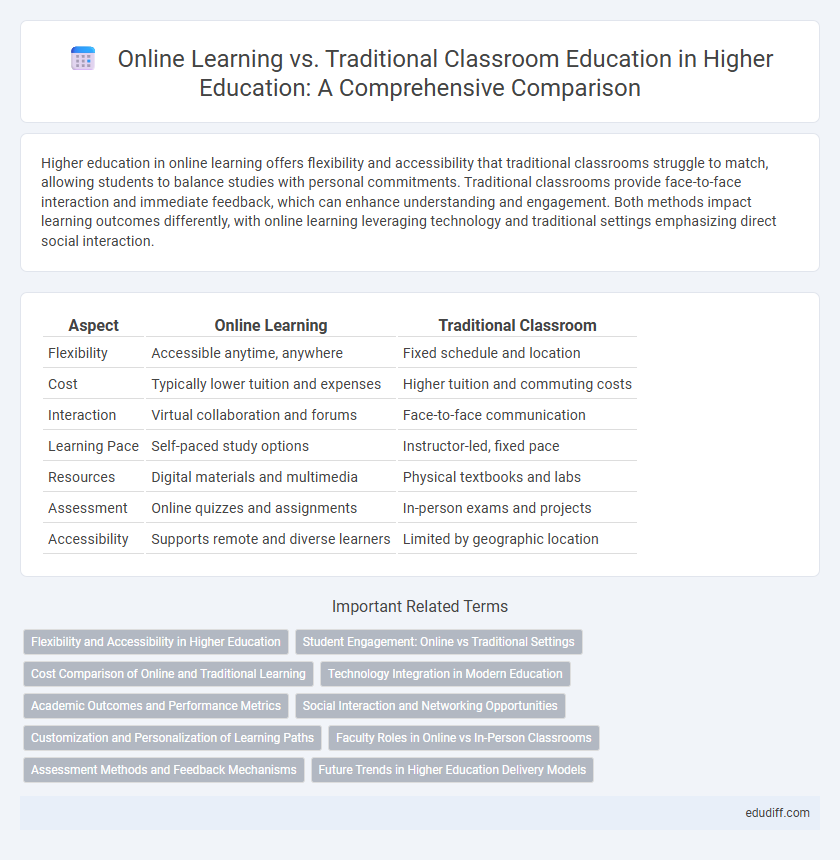Higher education in online learning offers flexibility and accessibility that traditional classrooms struggle to match, allowing students to balance studies with personal commitments. Traditional classrooms provide face-to-face interaction and immediate feedback, which can enhance understanding and engagement. Both methods impact learning outcomes differently, with online learning leveraging technology and traditional settings emphasizing direct social interaction.
Table of Comparison
| Aspect | Online Learning | Traditional Classroom |
|---|---|---|
| Flexibility | Accessible anytime, anywhere | Fixed schedule and location |
| Cost | Typically lower tuition and expenses | Higher tuition and commuting costs |
| Interaction | Virtual collaboration and forums | Face-to-face communication |
| Learning Pace | Self-paced study options | Instructor-led, fixed pace |
| Resources | Digital materials and multimedia | Physical textbooks and labs |
| Assessment | Online quizzes and assignments | In-person exams and projects |
| Accessibility | Supports remote and diverse learners | Limited by geographic location |
Flexibility and Accessibility in Higher Education
Online learning in higher education offers unparalleled flexibility, allowing students to access coursework anytime and anywhere, which accommodates diverse schedules and learning paces. Traditional classroom settings provide structured environments but often lack the same level of accessibility for non-traditional students, such as working professionals or those living in remote areas. Digital platforms and virtual classrooms significantly enhance accessibility by removing geographic and time constraints, making higher education more inclusive.
Student Engagement: Online vs Traditional Settings
Student engagement in online learning benefits from interactive multimedia tools, real-time feedback, and personalized pacing, which can enhance motivation and participation. Traditional classroom settings foster face-to-face interaction, immediate social cues, and group collaboration, which promote active discussions and peer learning. Studies indicate that combining both modalities through blended learning models maximizes engagement by leveraging the strengths of each environment.
Cost Comparison of Online and Traditional Learning
Online learning typically offers lower costs by eliminating expenses such as commuting, housing, and physical materials, making tuition fees more affordable compared to traditional classroom settings. Traditional learning often incurs additional costs related to campus facilities, on-site resources, and transportation, contributing to a higher overall financial burden for students. The flexibility of online programs allows for part-time enrollment, reducing lost income opportunities and further decreasing the total cost of education.
Technology Integration in Modern Education
Technology integration in modern education transforms both online learning and traditional classrooms by enhancing interactive engagement and personalized instruction. Digital tools like learning management systems, virtual labs, and real-time analytics enable educators to tailor content and track student progress effectively. This fusion of technology and pedagogy optimizes educational outcomes and supports diverse learning styles in higher education.
Academic Outcomes and Performance Metrics
Online learning platforms often utilize adaptive technologies and real-time analytics to enhance student engagement and track academic progress, resulting in comparable or improved performance metrics relative to traditional classroom settings. Studies indicate that metrics such as test scores, retention rates, and course completion rates in online environments show significant gains, especially when interactive content and personalized feedback are integrated. While traditional classrooms provide face-to-face interaction fostering social learning, online modalities offer flexible pacing, contributing positively to diverse learning outcomes and academic achievement benchmarks.
Social Interaction and Networking Opportunities
Online learning platforms offer flexible social interaction through discussion forums, virtual study groups, and live video sessions, enabling students to connect globally beyond geographical constraints. Traditional classrooms provide face-to-face networking opportunities, fostering immediate, personal relationships and spontaneous collaboration essential for skill development and professional growth. Both modalities support social engagement, but traditional environments often yield deeper, more organic interpersonal connections crucial for career networking.
Customization and Personalization of Learning Paths
Online learning offers highly customizable and personalized learning paths using adaptive technology that tailors content to individual student needs, pace, and learning style. Traditional classrooms typically follow a fixed curriculum with limited flexibility for personalization, often relying on a one-size-fits-all approach. Data-driven platforms in online education enable real-time progress tracking and adjustments, enhancing learner engagement and outcomes significantly.
Faculty Roles in Online vs In-Person Classrooms
Faculty roles in online learning emphasize technological proficiency, virtual engagement, and asynchronous communication to facilitate student interaction and deliver content effectively. In traditional classrooms, faculty prioritize face-to-face interaction, real-time feedback, and spontaneous discussions to enhance learning experiences. Adapting instructional strategies to each environment ensures faculty effectively support student success and maintain academic rigor.
Assessment Methods and Feedback Mechanisms
Online learning employs digital assessment tools such as quizzes, discussion boards, and automated grading systems to provide immediate feedback, enhancing the learning experience by allowing learners to track their progress in real-time. Traditional classrooms rely heavily on written exams, oral presentations, and in-person evaluations, offering direct interaction between students and instructors for personalized feedback. Both methods aim to assess knowledge effectively, but online platforms prioritize continuous, data-driven feedback while traditional settings emphasize qualitative insights through face-to-face communication.
Future Trends in Higher Education Delivery Models
Future trends in higher education delivery models emphasize hybrid learning environments combining online platforms with traditional classroom experiences to enhance flexibility and accessibility. Personalized learning analytics and AI-driven tools will optimize student engagement and outcomes, reshaping curriculum design and instructional methods. Institutions are increasingly adopting micro-credentials and competency-based education to meet evolving workforce demands and lifelong learning needs.
Online Learning vs Traditional Classroom Infographic

 edudiff.com
edudiff.com